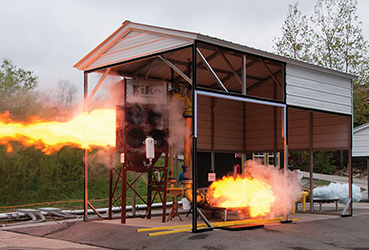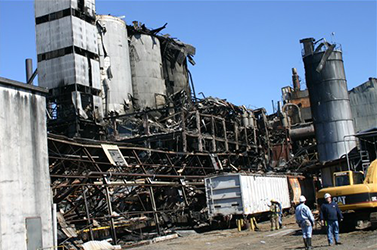
Combustible Dusts: What you need to know in Canada
Mike Edwards
Features combustible dust Fike safety Fike remote test facility
Fike remote test facility Do you need to worry about combustible dusts in your facility here in Canada? The answer is a definitive Yes! You may not even realize the dust in your facility is combustible, but you would be surprised what materials can explode when in a dust form.
By Jeff Mycroft
The list of dust which are combustible is extensive, they vary across a wide-ranging spectrum of industries, including the food, wood, chemical, paper, plastics, pharmaceutical, and metal processing industries.
Combustible dust accumulation is all too often an ignored hazard which if allowed unchecked accumulates in, and around your process machinery and vessels, settles on your floors, beams and all horizontal surfaces is a very real danger.
Combustible dust incidents have resulted in more than 342 fatalities worldwide last year alone, with an additional 441 injuries. There currently is no formal body collecting the data on combustible dust incidents, however they happen more often than most people realize. The US Chemical Safety Board identified 392 combustible dust incidents in the United States alone between 1980 and 2017, causing 185 fatalities and injuring 1,055 people.
Canada has not been immune to these incidents as well. In 2012 alone, multiple explosions caused the death of 4 workers and injured 41 more, but currently we have no system in place to record and report combustible dust incidents. There isn’t even a real way to track how many incidents are occurring, however they are happening with a frequency that can’t be ignored.
There are numerous laws across Canada which require you to address the combustible dusts in your facility. These include but aren’t limited to; the provincial Occupational Health and Safety Acts, the National and Provincial Fire codes, not to mention provincial requirements such as the ‘Pre-start safety and Health review’ (or PSR/PSHR) in Ontario, among others.
Failure to protect your facility and workers from combustible dust hazards can result in hefty fines, stop work orders and even criminal charges all across Canada. Large fines are increasingly common, and criminal charges usually follow fatalities. Just ask Veolia Sarnia, ON, who received $218,000 fine earlier this year when a combustible dust explosion claimed the life of an employee, not to mention the criminal charges laid against the manager, as well as the owner.
In existing facilities there is quite often a common misconception that the equipment and safety systems are adequate because of some sort of ‘grandfathering,’ however the grandfather clause doesn’t apply in virtually all circumstances, and ignorance of the hazard just doesn’t fly with authorities anymore. If you have dust in your facility and you can’t prove it isn’t combustible, then you are in a precarious position if you don’t have the proper safety systems in place.
The process to ensure your facilities are safe and compliant doesn’t have to be complicated. The first step is simple, determine if your dust(s) are in fact combustible (and if the dust is combustible how severe that combustion will be if ignition occurs). The proper test to determine this is the 20L Dust explosibility test which is performed to the dust testing standard ASTM E1226.
In order to perform this test, you will be required to collect approximately 1 kg of the finest dust in your facility. The reason for this is the finest dust stays airborne the longest, accumulates on all horizontal surfaces and collects on the filter media of your air material separators among other equipment. Even if a great majority of the material you are handling in your facility is large particulate, the fines tend to accumulate and represent the actual hazard.
A good example of this can be illustrated with common granular sugar. When you pour sugar out of a larger bag into a serving container, a great majority of the sugar is granular and falls out of the bag and into the container, whereas the fines create a small dust cloud above the container floating around with the air currents. This fine dust in an industrial process will stay suspended, travel and accumulate. There are explosion protection process safety companies located in Canada that can provide this testing service as well as international testing experts in the U.S.
If the test determines that your dust(s) are in fact not combustible then you don’t need to do anything further on the safety compliance side of combustible dusts, but ensure you keep the combustibility report to prove it. Please note you may still have environmental & health issues with respect to the airborne dusts — but that isn’t covered in this article. Additionally, if you change your process and a new material is being processed you will need to subsequently test that dust as well to ensure it isn’t combustible.
However, if the test determines that your dust is combustible, then the report will also include various other information on the properties of the dust. The two values you will focus on are the Kst, and Pmax.
The Kst is the rate of pressure rise of the combustible dust, and the Pmax is the maximum overpressure achieved in the test chamber. Another way of saying that is the Pmax lets you know how much pressure an explosion is capable of generating, and the Kst lets you know how fast the explosion will occur.
The Kst values are often broken into three classes (ST1 dusts being the least severe with values ranging from greater than 0 to 200, ST2 ranging from 201-300 and ST3 being the most severe with values above 300) but this can be deceiving as a great majority of all severe dust explosions throughout history have occurred with class 1 dusts. As a point of reference any Kst above zero means the dust is combustible and is a hazard.
Once you have determined your dust is in fact combustible and you have a safety hazard in your facility you need to address this issue as quickly as possible. If there is combustible dust in the air, on your floors, or any other horizontal surfaces, you should take steps to immediately and SAFELY remove it and prevent it from accumulating in the future. There is a very effective standard available which will help you handle and remove the combustible dust from your facility. It is called NFPA 654 – 2017 Standard for the Prevention of Fire and Dust Explosions from the Manufacturing, Processing, and Handling of Combustible Particulate Solids. This standard is available to you online to view for free, or to download for a fee from the NFPA website.
At the same time, you will need to determine if any of the vessels in your facility that generate, store, convey, separate, dry, mix, or collect this combustible dust also pose a hazard and require explosion protection. In some cases, the vessel may already have some sort of explosion protection, but unless you have documentation proving the protection was designed correctly, addresses all of the issues and is still applicable, it will need to be reviewed and confirmed that it is in fact safe.
Explosion protection has changed a lot over the last few decades and some of the equipment and methodologies that used to be standard are not only not used anymore, and actually pose a large hazard. Other technologies like ‘explosion doors’ require regular latch maintenance and calibration, but this is rarely done.
There are also a shockingly large number of vessels that are located inside a building (which have been identified as having an explosion hazard) been provided with explosion venting but direct the explosion vent inside the building (in the event of an explosion the vent would open and fill the room with pressure and a large fireball).
This is in direct violation of the National Fire Code as well as every Provincial Fire Code. Explosion vents must be directed outside of the building into an area that is not normally occupied by personnel. The fireball leaving a vessel can be exceptionally large, and in some cases exceeding 20 metres in length.
In order to help you determine which vessels pose a hazard, the risk level and how to protect your facility and personnel from any hazards you will want to engage an expert to help you. The expert will guide you through this process providing options along the way to protect the equipment, process, personnel and facility from the effects of a combustible dust incident.
Jeff Mycroft is a recognized expert in the field of explosion protection with over 25 years of experience. He works for safety solutions provider Fike Canada, Inc.
Print this page
